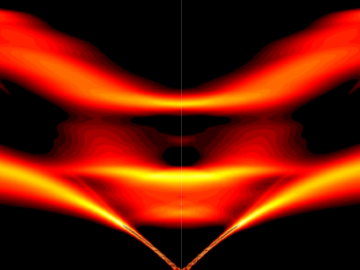
Filter News
Area of Research
- (-) Biology and Environment (66)
- (-) Materials (55)
- Advanced Manufacturing (3)
- Biological Systems (2)
- Computational Biology (2)
- Computational Engineering (1)
- Electricity and Smart Grid (1)
- Energy Science (43)
- Functional Materials for Energy (1)
- Fusion and Fission (11)
- Fusion Energy (8)
- Isotope Development and Production (1)
- Isotopes (10)
- Materials for Computing (4)
- National Security (7)
- Neutron Science (34)
- Nuclear Science and Technology (21)
- Nuclear Systems Modeling, Simulation and Validation (1)
- Quantum information Science (2)
- Supercomputing (67)
News Topics
- (-) Advanced Reactors (4)
- (-) Bioenergy (52)
- (-) Biomedical (20)
- (-) Frontier (6)
- (-) Physics (29)
- (-) Space Exploration (2)
- 3-D Printing/Advanced Manufacturing (27)
- Artificial Intelligence (15)
- Big Data (11)
- Biology (74)
- Biotechnology (14)
- Buildings (5)
- Chemical Sciences (36)
- Clean Water (14)
- Composites (11)
- Computer Science (34)
- Coronavirus (14)
- Critical Materials (13)
- Cybersecurity (5)
- Energy Storage (37)
- Environment (102)
- Exascale Computing (6)
- Fusion (8)
- Grid (8)
- High-Performance Computing (24)
- Hydropower (8)
- Irradiation (1)
- Isotopes (13)
- ITER (1)
- Machine Learning (12)
- Materials (78)
- Materials Science (82)
- Mathematics (4)
- Mercury (7)
- Microscopy (34)
- Molten Salt (3)
- Nanotechnology (42)
- National Security (5)
- Neutron Science (36)
- Nuclear Energy (16)
- Partnerships (13)
- Polymers (18)
- Quantum Computing (3)
- Quantum Science (11)
- Security (3)
- Simulation (16)
- Summit (11)
- Transportation (15)
Media Contacts

In the search to create materials that can withstand extreme radiation, Yanwen Zhang, a researcher at the Department of Energy’s Oak Ridge National Laboratory, says that materials scientists must think outside the box.

Scientists at the Department of Energy Manufacturing Demonstration Facility at ORNL have their eyes on the prize: the Transformational Challenge Reactor, or TCR, a microreactor built using 3D printing and other new approaches that will be up and running by 2023.

With the rise of the global pandemic, Omar Demerdash, a Liane B. Russell Distinguished Staff Fellow at ORNL since 2018, has become laser-focused on potential avenues to COVID-19 therapies.

In the race to identify solutions to the COVID-19 pandemic, researchers at the Department of Energy’s Oak Ridge National Laboratory are joining the fight by applying expertise in computational science, advanced manufacturing, data science and neutron science.

Researchers at the Department of Energy’s Oak Ridge National Laboratory have used Summit, the world’s most powerful and smartest supercomputer, to identify 77 small-molecule drug compounds that might warrant further study in the fight

Scientists at have experimentally demonstrated a novel cryogenic, or low temperature, memory cell circuit design based on coupled arrays of Josephson junctions, a technology that may be faster and more energy efficient than existing memory devices.

Researchers at the Department of Energy’s Oak Ridge National Laboratory have received five 2019 R&D 100 Awards, increasing the lab’s total to 221 since the award’s inception in 1963.

Using additive manufacturing, scientists experimenting with tungsten at Oak Ridge National Laboratory hope to unlock new potential of the high-performance heat-transferring material used to protect components from the plasma inside a fusion reactor. Fusion requires hydrogen isotopes to reach millions of degrees.
A team of scientists led by Oak Ridge National Laboratory have discovered the specific gene that controls an important symbiotic relationship between plants and soil fungi, and successfully facilitated the symbiosis in a plant that

Scientists have discovered a way to alter heat transport in thermoelectric materials, a finding that may ultimately improve energy efficiency as the materials


